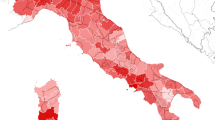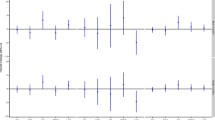Abstract
Summary
We hypothesized that chronic exposures to traffic combustion products may lower bone mineral density (BMD). We found that proximity to freeways was associated with reduced BMD. Our findings suggest that traffic-related pollution may contribute to the occurrence of osteopenia and osteoporosis.
Introduction
Adults residing in rural areas have been linked with higher BMD. We aimed to determine if this difference is due in part to air pollution by examining the relationships between traffic metrics and ambient air pollution with total body and pelvic BMD.
Methods
Mexican American adults (n = 1,175; mean 34 years; 72 % female) who had participated in the BetaGene study of air pollution, obesity, and insulin resistance were included in this analysis. Total body and pelvic BMD were estimated using dual-energy X-ray absorptiometry. Traffic and ambient air pollutant exposures were estimated at residences using location and ambient monitoring data. Variance component models were used to analyze the associations between residential distance to the nearest freeway and ambient air pollutants with BMD.
Results
Residential proximity to a freeway was associated with lower total body BMD (p-trend = 0.01) and pelvic BMD (p-trend = 0.03) after adjustment for age, sex, weight, and height. The adjusted mean total body and pelvic BMD in participants living within 500 m of a freeway were 0.02 and 0.03 g/cm2 lower than participants living greater than 1,500 m from a freeway. These associations did not differ significantly by age, sex, or obesity status. Results were similar after further adjustment for body fat and weekly physical activity minutes. Ambient air pollutants (NO2, O3, and PM2.5) were not significantly associated with BMD.
Conclusions
Traffic-related exposures in overweight and obese Mexican Americans may adversely affect BMD. Our findings indicate that long-term exposures to traffic may contribute to the occurrence of osteoporosis and its consequences.


Similar content being viewed by others
References
WHO (2003) Prevention and management of osteoporosis. WHO Technical Report Series. World Health Organization, Geneva
National Osteoporosis Foundation (2002) America's bone health: the state of osteoporosis and low bone mass in our nation. Available: http://nof.org/files/nof/public/content/file/63/upload/49.pdf. Accessed on 18 March 2014
Lorentzon M, Mellström D, Haug E, Ohlsson C (2007) Smoking is associated with lower bone mineral density and reduced cortical thickness in young men. J Clin Endocrinol Metabol 92:497–503
Holmberg T, Bech M, Curtis T, Juel K, Gronbaek M, Brixen K (2011) Association between passive smoking in adulthood and phalangeal bone mineral density: results from the KRAM study—the Danish Health Examination Survey 2007–2008. Osteoporos Int 22:2989–2999
Heaney RP (1993) Nutritional factors in osteoporosis. Annu Rev Nutr 13:287–316
Pigozzi F, Rizzo M, Giombini A, Parisi A, Fagnani F, Borrione P (2009) Bone mineral density and sport: effect of physical activity. J Sports Med Phys Fitness 49:177–183
Sommer I, Erkkila AT, Jarvinen R, Mursu J, Sirola J, Jurvelin JS, Kroger H, Tuppurainen M (2013) Alcohol consumption and bone mineral density in elderly women. Public Health Nutr 16:704–712
Barrett-Connor E, Laughlin GA, Li H et al (2012) The association of concurrent vitamin D and sex hormone deficiency with bone loss and fracture risk in older men: the osteoporotic fractures in men (MrOS) study. J Bone Miner Res 27:2306–2313
Shoback D (2007) Update in osteoporosis and metabolic bone disorders. J Clin Endocrinol Metabol 92:747–753
Gu W, Rennie KL, Lin X, Wang Y, Yu Z (2007) Differences in bone mineral status between urban and rural Chinese men and women. Bone 41:393–399
Specker B, Binkley T, Fahrenwald N (2004) Rural versus nonrural differences in BMC, volumetric BMD, and bone size: a population-based cross-sectional study. Bone 35:1389–1398
Omsland TK, Ahmed LA, Gronskag A et al (2011) More forearm fractures among urban than rural women: the NOREPOS study based on the Tromso study and the HUNT study. J Bone Miner Res 26:850–856
Sanders KM, Nicholson GC, Ugoni AM, Seeman E, Pasco JA, Kotowicz MA (2002) Fracture rates lower in rural than urban communities: the Geelong Osteoporosis Study. J Epidemiol Community Health 56:466–470
Calderon-Garciduenas L, Mora-Tiscareno A, Francolira M et al (2013) Exposure to urban air pollution and bone health in clinically healthy six-year-old children. Arh Hig Rada Toksikol 64:23–34
Cevei M, Stoicanescu D (2010) Air pollution and genetic influences on bone mineral density and osteoporosis. Analele Universitatii din Oradea, Fascicula Biologie TOM XVII/1:84-89
Alvær K, Meyer HE, Falch JA, Nafstad P, Søgaard AJ (2007) Outdoor air pollution and bone mineral density in elderly men—the Oslo Health Study. Osteoporos Int 18:1669–1674
World Health Organization (WHO) (2014) Air quality deteriorating in many of the world’s cities. Available at http://www.who.int/mediacentre/news/releases/2014/air-quality/en/. Accessed Dec. 12th 2014
Watanabe RM, Allayee H, Xiang AH, Trigo E, Hartiala J, Lawrence JM, Buchanan TA (2007) Transcription factor 7-like 2 (TCF7L2) is associated with gestational diabetes mellitus and interacts with adiposity to alter insulin secretion in Mexican Americans. Diabetes 56:1481–1485
Kolonel LN, Henderson BE, Hankin JH, Nomura AMY, Wilkens LR, Pike MC, Stram DO, Monroe KR, Earle ME, Nagamine FS (2000) A multiethnic cohort in Hawaii and Los Angeles: baseline characteristics. Am J Epidemiol 151:346–357
Willett WC, Sampson L, Stampfer MJ, Rosner B, Bain C, Witschi J, Hennekens CH, Speizer FE (1985) Reproducibility and validity of a semiquantitative food frequency questionnaire. Am J Epidemiol 122:51–65
Benson PE, Pinkerman KO, Laboratory COoT, Administration USFH (1984) CALINE4—a dispersion model for predicting air pollution concentrations near roadways. State of California, Dept. of Transportation, Division of Engineering Services, Office of Transportation Laboratory
Zhu Y, Hinds WC, Kim S, Sioutas C (2002) Concentration and size distribution of ultrafine particles near a major highway. J Air Waste Manag Assoc 52:1032–1042
WHO (1995) World Health Organization. Physical status: the use and interpretation of anthropometry. Available at: http://whqlibdoc.who.int/trs/WHO_TRS_854.pdf. Accessed on April 7th 2014
Looker A, Borrud L, Hughes J, B F, Shepherd J, Melton LI (2012) Lumbar spine and proximal femur bone mineral density, bone mineral content, and bone area: United States, 2005–2008. Hyattsville, Md.: Dept. of Health and Human Services, Public Health Service, National Center for Health Statistics, p 10
National Institute on Aging (2013) Menopause. Available: http://www.nia.nih.gov/health/publication/menopause. National Institute on Aging, National Institutes of Health, U.S. Department of Health and Human Services. Accessed Dec. 1st 2014
Gold EB, Bromberger J, Crawford S, Samuels S, Greendale GA, Harlow SD, Skurnick J (2001) Factors associated with age at natural menopause in a multiethnic sample of midlife women. Am J Epidemiol 153:865–874
Chau DL, Edelman SV (2002) Osteoporosis and diabetes. Clin Diab 20:153–157
Chau DL, Mulvihill M, Moore T, Bouno M, Ramsdell J, Hovell M (2002) Oral presentation: “Post-partum bone loss in Latino women with prior gestational diabetes”. Western Regional Meeting of the American Federation of Medical Research
To WWK, Wong MWN (2008) Bone mineral density changes in gestational diabetic pregnancies—a longitudinal study using quantitative ultrasound measurements of the os calcis. Gynecol Endocrinol 24:519–525
Lu H, Fu X, Ma X, Wu Z, He W, Wang Z, Allison D, Heymsfield S, Zhu S (2011) Relationships of percent body fat and percent trunk fat with bone mineral density among Chinese, Black, and White subjects. Osteoporos Int 22(12):3029–3035
Rundle A, Hoepner L, Hassoun A et al (2012) Association of childhood obesity with maternal exposure to ambient air polycyclic aromatic hydrocarbons during pregnancy. Am J Epidemiol 175(11):1163–1172
Oncken C, Prestwood K, Kleppinger A, Wang Y, Cooney J, Raisz L (2006) Impact of smoking cessation on bone mineral density in postmenopausal women. J Womens Health (Larchmt) 15:1141–1150
Lee LL, Lee JS, Waldman SD, Casper RF, Grynpas MD (2002) Polycyclic aromatic hydrocarbons present in cigarette smoke cause bone loss in an ovariectomized rat model. Bone 30:917–923
Brook RD, Rajagopalan S, Pope CA et al (2010) Particulate matter air pollution and cardiovascular disease: an update to the scientific statement from the American Heart Association. Circulation 121:2331–2378
Lorenzo J, Horowitz M, Choi Y (2008) Osteoimmunology: interactions of the bone and immune system. Endocr Rev 29:403–440
Manolagas SC (2000) Birth and death of bone cells: basic regulatory mechanisms and implications for the pathogenesis and treatment of osteoporosis. Endocr Rev 21:115–137
Pfeilschifter J, Koditz R, Pfohl M, Schatz H (2002) Changes in proinflammatory cytokine activity after menopause. Endocr Rev 23:90–119
Giuliani N, Sansoni P, Girasole G, Vescovini R, Passeri G, Passeri M, Pedrazzoni M (2001) Serum interleukin-6, soluble interleukin-6 receptor and soluble gp130 exhibit different patterns of age- and menopause-related changes. Exp Gerontol 36:547–557
Ding C, Parameswaran V, Udayan R, Burgess J, Jones G (2008) Circulating levels of inflammatory markers predict change in bone mineral density and resorption in older adults: a longitudinal study. J Clin Endocrinol Metab 93:1952–1958
Deiuliis JA, Kampfrath T, Zhong J, Oghumu S, Maiseyeu A, Chen LC, Sun Q, Satoskar AR, Rajagopalan S (2012) Pulmonary T cell activation in response to chronic particulate air pollution. Am J Physiol Lung Cell Mol Physiol 302:L399–L409
Mikuls TR, Saag KG, Curtis J et al (2005) Prevalence of osteoporosis and osteopenia among African Americans with early rheumatoid arthritis: the impact of ethnic-specific normative data. J Natl Med Assoc 97:1155–1160
Takayanagi H, Ogasawara K, Hida S et al (2000) T-cell-mediated regulation of osteoclastogenesis by signalling cross-talk between RANKL and IFN-gamma. Nature 408:600–605
Moller P, Loft S (2010) Oxidative damage to DNA and lipids as biomarkers of exposure to air pollution. Environ Health Perspect 118:1126–1136
Frank L, Engelke P, Schmid T (2003) Health and community design: the impact of the built environment on physical activity. Island Press
American Lung Association (2010) Tobacco use. Available at: http://www.lung.org/assets/documents/publications/solddc-chapters/tobacco.pdf. Accessed Dec. 17 2014
Acknowledgments
This work was supported by National Institutes of Health grants DK-061628, M01-RR-0043 and UL1-TR000130; Clinical Research Grant 7-09-CT-09 from the American Diabetes Association Research Award; the Southern California Environmental Health Sciences Center (grant 5P30ES007048) funded by the National Institute of Environmental Health Sciences; National Institute of Environmental Health Sciences (grant 5P01ES011627); and the Hastings Foundation.
Conflicts of interest
None.
Author information
Authors and Affiliations
Corresponding author
Electronic supplementary material
Below is the link to the electronic supplementary material.
ESM 1
(DOCX 25 kb)
Rights and permissions
About this article
Cite this article
Chen, Z., Salam, M.T., Karim, R. et al. Living near a freeway is associated with lower bone mineral density among Mexican Americans. Osteoporos Int 26, 1713–1721 (2015). https://doi.org/10.1007/s00198-015-3051-z
Received:
Accepted:
Published:
Issue Date:
DOI: https://doi.org/10.1007/s00198-015-3051-z




